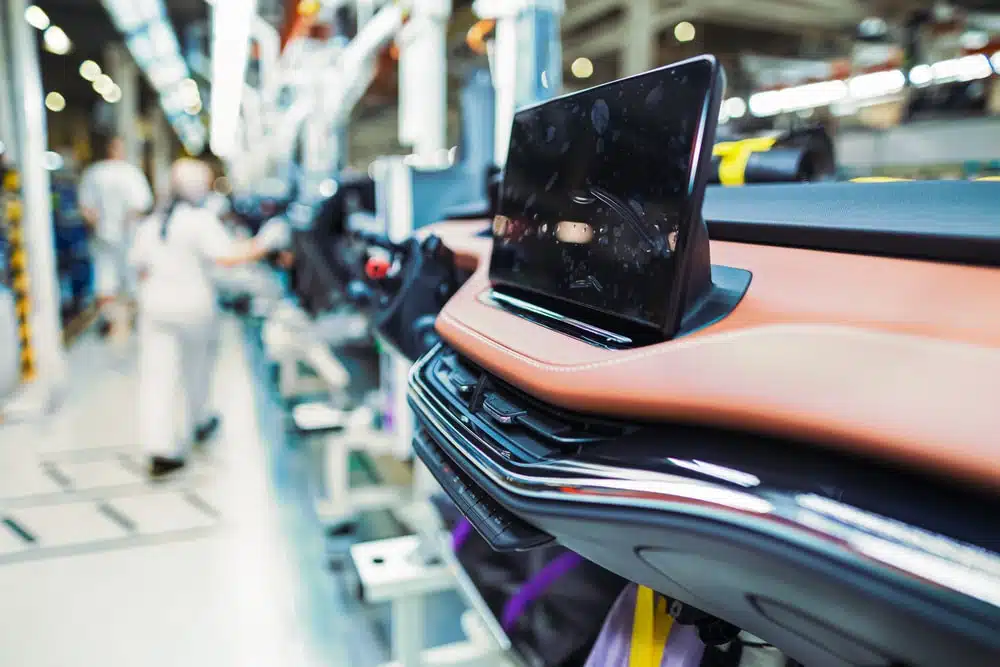In the ever-evolving manufacturing landscape, just in time manufacturing has proven to be a game-changer. Born in post-WWII Japan, this revolutionary production model, called lean manufacturing, focuses on producing goods as needed, reducing inventory costs, and increasing efficiency. As you dive into this blog post, expect to unearth the principles behind JIT manufacturing, its successful implementation, advantages, challenges, and real-world applications across different industries.
Key Takeaways
-
Just in Time (JIT) Manufacturing is a lean production model that reduces lead times and costs by minimizing waste, optimizing resources, and employing an inventory management pull system.
-
Building strong supplier relationships, standardizing processes, and leveraging technology solutions such as JIT inventory management software & automation are essential for the successful implementation of JIT manufacturing.
-
Advantages include reduced costs & waste, while potential risks include supply chain disruptions & difficulty adapting to sudden demand fluctuations.
Understanding Just-in-Time Manufacturing
Just in time manufacturing, a lean production model, targets high-volume production with minimal inventory, eradicates wastage, and efficiently meets customer demand. JIT is one of the most successful inventory management systems. It requires:
-
steady production
-
high-quality workmanship
-
glitch-free plant machinery &
-
reliable suppliers
to function properly. A key aspect of JIT is continuous flow manufacturing, which emphasizes effective communication and coordination between suppliers and manufacturers to streamline production processes and enhance efficiency.

Contrasting with push inventory systems, JIT employs a pull system that orders inventory to meet actual demand, ensuring that businesses produce only what is needed.
Origins of JIT Manufacturing
Just in Time (JIT) manufacturing has its roots in post-World War II Japan, where the country faced severe shortages of capital, storage space, and natural resources. In response to these challenges, Taiichi Ohno, a Japanese industrial engineer, developed the Toyota Production System (TPS), which later became known as JIT manufacturing. Ohno’s methodology aimed to minimize waste and maximize efficiency in all production areas. In the 1950s and 1960s, Toyota’s manufacturing facilities were the first to use the TPS, and other businesses all over the world later adopted it.
The Toyota Production System revolutionized the manufacturing industry by introducing principles that focused on producing only what was needed, when it was needed, and in the amount needed. This approach not only reduced inventory costs but also improved overall production efficiency. The success of TPS and JIT manufacturing at Toyota set a new standard in the industry, demonstrating that it was possible to achieve high levels of productivity and quality with minimal waste.
Key Principles of JIT Manufacturing
JIT manufacturing revolves around a few core principles: waste minimization, resource optimization, and a pull system for comprehensive inventory management. The pull system, a method of managing inventory, guarantees that materials are only ordered when required, allowing businesses to produce only what is needed.
Short-cycle manufacturing is another term used to describe similar methodologies aimed at improving efficiency and reducing waste.

Resource optimization in JIT manufacturing is achieved through:
-
Waste reduction, including efficient use of raw materials
-
Cash flow improvement
-
Increased flexibility
-
Human resources utilization
-
Minimization of lead times and production costs
By establishing strong relationships with suppliers and implementing supply chain visibility, JIT ensures that materials are available only when necessary, reducing excess inventory and associated costs.
The Toyota Production System
The Toyota Production System (TPS) is the origin of JIT manufacturing, developed in post-WWII Japan to minimize resource consumption. Japanese industrial engineers Taiichi Ohno and Eiji Toyoda formulated this system as a response to resource constraints faced by post-war Japan and a challenge to catch up to American manufacturing practices. TPS revolutionized the manufacturing industry by introducing the concept of lean manufacturing. It focused on eradicating waste, optimizing efficiency, and constantly striving for improvement.
TPS revolutionized manufacturing on a global scale, and numerous other businesses have since adopted its guiding principles, having a notable impact on the sector by increasing productivity, lowering costs, and raising quality.
Lean Manufacturing and JIT
Lean manufacturing is a production methodology that aims to reduce waste and maximize efficiency in all production areas. JIT manufacturing is a key component of lean manufacturing, as it focuses on producing goods only as needed to meet customer demand. Lean manufacturing and JIT share the same goal of eliminating waste and improving efficiency, but lean manufacturing is a broader concept that encompasses JIT and other production methodologies.
Lean manufacturing is frequently associated with the Taiichi Ohno-developed Toyota Production System (TPS). TPS introduced the world to the concept of continuous improvement and the relentless pursuit of efficiency. By integrating JIT manufacturing into the broader framework of lean manufacturing, companies can ensure that they are not only meeting customer demand but also continuously improving their production processes to eliminate waste and enhance productivity.
Implementing JIT Manufacturing in Your Business
A successful implementation of JIT manufacturing in a business hinges on fostering strong supplier relationships, establishing standardized processes, and maintaining a commitment to continuous improvement. Just-in-Time manufacturing relies on long-term contracts with reliable suppliers, ensuring that materials are delivered on time.
For businesses to optimize their JIT manufacturing operations, it’s crucial to standardize processes and embrace continuous improvement practices.
Building Strong Supplier Relationships
The success of JIT manufacturing largely depends on the establishment of strong supplier relationships, ensuring prompt delivery of materials. Effective communication between buyers and suppliers promotes trust, understanding, and collaboration while also facilitating the clear and timely exchange of information, such as production schedules, inventory levels, and quality requirements.
Open and transparent communication fosters strong partnerships between suppliers and manufacturers, resulting in improved efficiency, dependability, and responsiveness in the JIT manufacturing process.
Standardizing Processes and Embracing Continuous Improvement
Standardizing processes in the context of JIT manufacturing denotes the establishment of precise and consistent procedures for every step in the production process. JIT manufacturing aims to eliminate waste, reduce variability, and boost overall productivity through process standardization. Continuous improvement is strongly associated with JIT manufacturing, as it necessitates incessantly analyzing and optimizing processes to eradicate inefficiencies and enhance overall performance.

The introduction of continuous improvement practices allows organizations to:
-
Identify and rectify areas of improvement in their JIT manufacturing systems
-
Increase productivity
-
Lower costs
-
Improve customer satisfaction
JIT Manufacturing and Employee Involvement
JIT manufacturing requires active employee involvement to ensure its success. Employees are encouraged to participate in continuous improvement activities, such as identifying and eliminating waste, improving production processes, and suggesting new ideas for improvement. Employee involvement is critical in JIT manufacturing, as it helps to identify and address problems quickly, improve product quality, and increase productivity.
In a JIT manufacturing environment, employees are often cross-trained to perform multiple tasks, allowing for greater flexibility and adaptability in response to changing customer demand. This level of engagement and responsibility empowers employees to take ownership of their work and contribute to the overall success of the production process. By fostering a culture of continuous improvement, JIT manufacturing ensures that employees are always looking for ways to enhance efficiency and reduce waste.
Advantages and Challenges of JIT Manufacturing
While JIT manufacturing offers benefits such as reduced waste, improved efficiency, and lower costs, it also comes with potential risks and drawbacks. Unlike traditional mass production methods, which typically utilize push inventory strategies leading to inefficiencies such as overproduction and excess inventory, JIT aims to eliminate waste and enhance production flexibility based on real customer demand.
Small businesses that generate consistent sales but experience periods of low inventory, such as:
-
Auto repair shops
-
Bookstores
-
Fast food restaurants
-
Construction businesses
-
Florists
-
Retail stores
Companies can take advantage of the JIT system.

Benefits of JIT Manufacturing
The advantages offered by JIT manufacturing include lower inventory levels, reduced costs, and enhanced efficiency. It reduces large raw material spends, labor costs, inventory costs, and shortens lead times, while also improving quality and diminishing storage and maintenance costs.
JIT manufacturing boosts efficiency by reducing flow times and wastage, increasing productivity, and slashing costs. By synchronizing raw material orders with production schedules, JIT enables retailers to ensure their stock is moving efficiently and to avoid unnecessary inventory.
Potential Risks and Drawbacks
This type of manufacturing comes with potential risks and drawbacks such as disruptions in the entire supply chain, dependence on suppliers, and challenges in adapting to sudden demand fluctuations. Supply chain disruptions can cause order fulfillment issues, delays in production and delivery commitments, and can even result in factories being unable to meet demand.
JIT also increases reliance on suppliers due to the necessity of close coordination and communication, which, if not maintained, could adversely affect the production process.
JIT Manufacturing and Quality Control
It places a strong emphasis on quality control, as producing high-quality products is essential to meeting customer demand and reducing waste. JIT manufacturing uses various quality control techniques, such as total quality control (TQC) and statistical process control (SPC), to ensure that products meet customer requirements. JIT Manufacturing also encourages employees to take ownership of quality control, as they are responsible for identifying and addressing quality issues quickly.
By focusing on quality control, JIT manufacturing helps to reduce waste, improve product quality, and increase customer satisfaction. High-quality products not only meet customer expectations but also reduce the need for rework and repairs, further enhancing the efficiency of the production process. In a JIT environment, quality control is not just a department but a fundamental aspect of the entire production process.
JIT Manufacturing in Different Industries
JIT is employed in a variety of industries, such as automotive, retail, and e-commerce. JIT production is popular across various industries due to increased efficiency and reduced operational costs. Large automobile manufacturers like Toyota utilize JIT by having their suppliers deliver parts to their factories in a timely manner, allowing for an expedited production process and minimizing the need for large inventory levels.
Automotive Industry
The automotive industry has been a pioneer in adopting JIT manufacturing, with companies such as Toyota leading the charge. Toyota utilizes various JIT practices, including:
-
Constructing cars to order
-
Guaranteeing the precise fit of components
-
Streamlining manufacturing processes
-
Reducing inventory levels
Retail and E-commerce
Retail and e-commerce businesses, such as Amazon and Apple, also employ JIT manufacturing to maintain a competitive advantage. Amazon implements JIT manufacturing in its operations by utilizing Just-In-Time inventory management, ensuring stock is supplied to meet production or consumer demand in a timely manner without unnecessary anticipation.
Apple has profited from utilizing JIT manufacturing in its supply chain by synchronizing production with demand, limiting holding costs, and decreasing inventory levels.
Comparing JIT Manufacturing to Alternative Inventory Strategies
Alternative inventory strategies like just-in-case (JIC) and just-in-sequence (JIS) manufacturing can serve as points of comparison to JIT manufacturing. JIC manufacturing seeks to minimize waste by procuring inventory solely as required for production, while JIC emphasizes the stocking of excess goods and surpassing existing demand to fulfill orders.
Just-in-Case (JIC) Manufacturing
While JIC manufacturing advocates for maintaining surplus stock to offset potential risks, it might lead to higher expenses and the risk of redundant resources. Key principles of JIC manufacturing include proactive purchasing in advance, sustaining inventory levels to accommodate unforeseen demand, and harmonizing efficiency and resilience in the supply chain.
JIC typically costs more than JIT due to the elevated inventory levels maintained, which result in higher inventory holding costs.
Just-in-Sequence (JIS) Manufacturing
Just-in-Sequence (JIS) manufacturing ensures that the necessary inventory is delivered in the exact order required for production, whereas Just-in-Time (JIT) manufacturing concentrates on minimizing inventory amounts.
The essential principles of JIS manufacturing are:
-
The provision of components at the appropriate time and in the exact sequence required for assembly or production
-
Alignment of part delivery with the assembly line’s needs
-
The improvement of efficiency, reduction of waste, and optimization of the production process.

Leveraging Technology for JIT Manufacturing Success
The role of technology is vital for the success of JIT manufacturing, particularly in terms of inventory management software and automation. JIT inventory management software, such as Netsuite ERP and Zoho Inventory, helps businesses effectively manage their JIT operations.
Automation and Industry 4.0 technologies can further enhance JIT manufacturing by streamlining processes and improving efficiency.
JIT Inventory Management Software
Organizations can optimize their JIT operations with the help of JIT inventory management software, which is a crucial component of a JIT inventory system. Examples of JIT inventory management software include Netsuite ERP and Zoho Inventory. The key features of Netsuite ERP for JIT inventory management include inventory tracking across multiple locations, automatic replenishment that takes into account lead times, real-time monitoring of stock levels, monitoring of suppliers and partners, cycle counting for precise stock levels, and traceability of inventory items.
Automation and Industry 4.0
The streamlining of processes and efficiency optimization in JIT manufacturing can be achieved through automation and Industry 4.0 technologies. Automation can be employed in JIT Manufacturing to reduce expenses, enhance worker safety, enable 24/7 production, provide real-time visibility and control, and eradicate bottlenecks and wastage.
Robotics and artificial intelligence play a crucial role in JIT manufacturing by automating monotonous operations, eliminating or reducing human error, and executing tasks such as cutting, measuring, packing, and palletizing.
JIT Manufacturing and Supply Chain Management
JIT manufacturing requires close coordination with suppliers to ensure that raw materials and components are delivered just in time to meet production schedules. JIT manufacturing uses various supply chain management techniques, such as vendor-managed inventory (VMI) and just-in-time delivery, to ensure that suppliers deliver goods and services on time. JIT manufacturing also encourages suppliers to participate in continuous improvement activities, such as identifying and eliminating waste, improving production processes, and suggesting new ideas for improvement.
By working closely with suppliers, JIT manufacturing helps to reduce inventory costs, improve product quality, and increase customer satisfaction. Effective supply chain management ensures that raw materials are available when needed, without the burden of excess inventory. This close collaboration between manufacturers and suppliers is essential for the smooth operation of JIT manufacturing, as it ensures that the entire production process is aligned with customer demand and production schedules.
Summary
In conclusion, Just-in-Time manufacturing has revolutionized the world of manufacturing by reducing waste, improving efficiency, and lowering costs. With its roots in the Toyota Production System, JIT manufacturing has spread across various industries, including automotive, retail, and e-commerce. By leveraging technology, such as inventory management software and automation, businesses can further optimize their JIT operations, securing their competitive edge in the market. Embrace the power of JIT manufacturing and unlock the full potential of your business.
Frequently Asked Questions
What is the meaning of just-in-time?
By having supplies arrive only when they are necessary for production or shipment, the just-in-time (JIT) inventory management strategy aims to maintain the minimal level of inventory required. It focuses on close collaboration with suppliers in order to receive goods as close as possible to when they are actually needed.
Is just-in-time still relevant?
It is clear that opinions are divided on the relevance of just-in-time; however, it appears that some form of strategy will still have a role in supply chains in the future.
What are the risks of just-in-time?
Just-in-Time (JIT) Manufacturing poses risks such as the risk of running out of stock, having to rely on the timeliness of suppliers, low in-transit visibility, difficulty reworking orders, problems with forecasting, coping with sudden increased demand, and reliance on a single supplier. Companies may also experience difficulty adapting to sudden surges in customer demand, which can lead to delays in shipment, potentially resulting in loss of customers.
What’s your excuse for not using JIT?
Executives often excuse themselves from using JIT, claiming it won’t work in their particular situation. However, this misperception can keep them from harnessing the power of JIT to improve production and efficiency.
What is the main objective of JIT manufacturing?
The main objective of JIT manufacturing is to increase production efficiency by minimizing inventory, reducing waste, and effectively meeting customer demand.






